« Milestones | Main | Getting the real scoop on new dive locations »
December 21, 2008
Return to Paradise
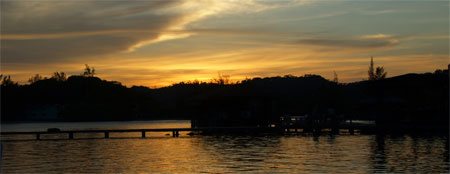
Flying back to Roatan felt like going back to paradise, but this time I knew what was coming, I knew the routine and knew what to expect. Another great week of exploring underwater at what must be one of the best dive resorts in the world.
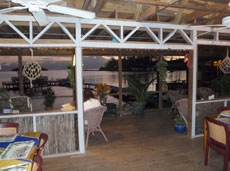 It was colder this time and occasionally there were rain clouds, gusts of wind, and the puddles of the rainy season. If that sounds like a bad thing, it wasn't. It was a wonderful week of diving at CoCo View resort that I wouldn’t want to miss for anything. The newness of the first trip there was replaced by the sheer joy of being back to a magical place and looking forward to all the things I knew I'd experience and enjoy. And discovering new things I'd missed the first time around. In a way it was like the difference between a first date and a great relationship. My initial romance with Roatan now seems destined to becoming a long-term relationship.
It was colder this time and occasionally there were rain clouds, gusts of wind, and the puddles of the rainy season. If that sounds like a bad thing, it wasn't. It was a wonderful week of diving at CoCo View resort that I wouldn’t want to miss for anything. The newness of the first trip there was replaced by the sheer joy of being back to a magical place and looking forward to all the things I knew I'd experience and enjoy. And discovering new things I'd missed the first time around. In a way it was like the difference between a first date and a great relationship. My initial romance with Roatan now seems destined to becoming a long-term relationship.
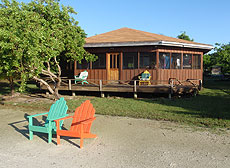 This time we stayed with our friends Bob and Diane from Tennessee. They’d been to CoCo View numerous times, qualifying them as “CoCo Nuts,†and they had rented one of the beach houses at Playa Miguel, the peninsula between the man-made canal and the beach. It was a nice place with generously sized showers, good water pressure and plenty of hot water (which is a very good thing on a dive trip). There were trail bikes to get back and forth between the resort and the beach houses and it all worked very well.
This time we stayed with our friends Bob and Diane from Tennessee. They’d been to CoCo View numerous times, qualifying them as “CoCo Nuts,†and they had rented one of the beach houses at Playa Miguel, the peninsula between the man-made canal and the beach. It was a nice place with generously sized showers, good water pressure and plenty of hot water (which is a very good thing on a dive trip). There were trail bikes to get back and forth between the resort and the beach houses and it all worked very well.
It was great to see familiar faces in the office, dive shop, dock and boats. I had looked forward to having Eddie and Jorge again, our boat crew from the summer, but this time we were assigned to the CoCo View II boat with divemaster Jessie and captain Ruben. They turned out to be great guys as well. Jessie is an easy-going, experienced divemaster who had also worked on an Aggressor liveaboard and is a master at finding and pointing out critters. And Ruben sure knows how steer the big boat through rough water.
I had wondered what the water temperature was going to be like in December. In August we’d had a balmy, tropical 86 degrees. In December it was more like 78 to 80 degrees, still warm but a definite difference, especially with the wind blowing when you got out of the water. The resort was full, too, with eating sections in the Clubhouse extending into the play and upstairs areas. The dive boats were full, too, with ours having 19 people assigned. A full house also meant that the lists for extracurricular and optional activities were quickly filling up. The shark and dolphin dives were all booked by Monday morning and so that decision was made for me. No sharks. Next time.
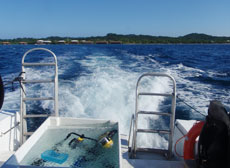 As returning guests we attended the orientation Sunday morning but skipped the orientation dive where those new to the resort were being shown the ropes. Instead, we went right to our first boat dive. In August I’d been a nervous wreck before that first ocean dive. This time I was completely calm and couldn't wait to get into the water. The first dive site on Sunday was Valley of the Kings, where the drop-off on top of the coral reef is around 30-35 feet and then there’s this gorgeous sloping, valley-like cut in the reef instead of just going over the edge of the wall. We'd done that site before, but last time I had stayed shallow as I'd been experiencing those nose bleeds and didn’t want to push it. This time I found myself completely comfortable and actually went down to 92 feet. Some sites lend themselves to deeper dives better than others. Visibility plays a factor, but also the terrain. Here, the viz was very good and the sloping valley made going a bit deeper easy and unintimidating.
As returning guests we attended the orientation Sunday morning but skipped the orientation dive where those new to the resort were being shown the ropes. Instead, we went right to our first boat dive. In August I’d been a nervous wreck before that first ocean dive. This time I was completely calm and couldn't wait to get into the water. The first dive site on Sunday was Valley of the Kings, where the drop-off on top of the coral reef is around 30-35 feet and then there’s this gorgeous sloping, valley-like cut in the reef instead of just going over the edge of the wall. We'd done that site before, but last time I had stayed shallow as I'd been experiencing those nose bleeds and didn’t want to push it. This time I found myself completely comfortable and actually went down to 92 feet. Some sites lend themselves to deeper dives better than others. Visibility plays a factor, but also the terrain. Here, the viz was very good and the sloping valley made going a bit deeper easy and unintimidating.
I also decided to use air instead of Nitrox. I think I was actually the only one on our boat who used air. I’d felt fine on Nitrox in August, but Nitrox cost eight dollars extra per tank while air was included. If you used Nitrox all week it cost US$125. I figured I’d do an average of three dives a day for a total of 18 dives, so I’d have paid about seven dollars extra per tank, still expensive. For those doing four dives or more a day it made perfect sense. Anyway, I did not want to feel like I needed Nitrox to dive or enjoy diving.
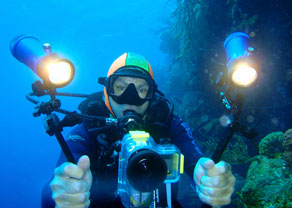 Was using air instead of Nitrox any different? Not in the way I felt. In fact, I felt exactly the same. I was warned that I’d feel tired and exhausted after a few days diving on air, but that did not happen. There is one difference, though. With air you do have to watch your dive computer more frequently so as to not break the limits of no-decompression diving. Every time I went deep (80-100 feet), the remaining nitrogen time quickly dropped. It also dropped if I descended again by just a few feet after I’d gradually come up to shallower depths.
Was using air instead of Nitrox any different? Not in the way I felt. In fact, I felt exactly the same. I was warned that I’d feel tired and exhausted after a few days diving on air, but that did not happen. There is one difference, though. With air you do have to watch your dive computer more frequently so as to not break the limits of no-decompression diving. Every time I went deep (80-100 feet), the remaining nitrogen time quickly dropped. It also dropped if I descended again by just a few feet after I’d gradually come up to shallower depths.
My second dive this time was a drop-off at Newman’s Wall. We went down to about 75 feet and began ascending when my computer showed eight minutes of remaining nitrogen time at that depth. Once we reached 30 feet about 35 minutes into the dive, nitrogen time was back up to 99 minutes, or unlimited. However, we then returned to the resort via the Prince Albert wreck and that got me back down to about 50 feet. Nitrogen time quickly dropped to just one minute and then I ran out and into my first-ever deco stop situation. The computer only wanted a minute at ten feet and the deco warning quickly disappeared as I slowly ascended, but it was a first for me and from then on I watched my dive computer even more carefully.
On my subsequent dives I found that my remaining nitrogen time was always considerably less than Carol’s, who was using Nitrox. I also found that diving deep (I had two dives deeper than 100 feet) was okay as far as nitrogen time goes as long as I then didn’t do another dip of more than 15 feet or so.
In all my dives, it was the recommended time limits of about 60 minutes per dive and my air consumption that determined the length of my dives, and not the fact that I used air. As far as air consumption goes, I fully expected to use a lot less this time around than back in August. Somehow that didn’t happen. Though I couldn’t have been calmer and more relaxed through most of my 16 dives, on some I actually used more. Go figure.
I got a chance to learn a bit more about how depth affects me. I am still convinced that psychology plays a big part. 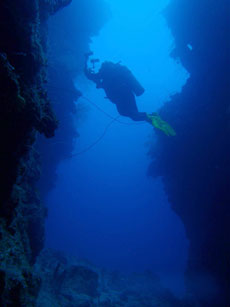 If you think something is going to happen or change at a certain depth, then likely it will. In his book "Deep Diving," author and deep diver Brett Gilliam mentions a study where symptoms developed pretty much based on what a group of divers was told would happen. Me, I did feel a little twinge of something every time I passed 100 feet. The air tasted different and I felt different. I also noticed that by and large, 80 feet seems to be the depth where I start feeling a little different. It’s an entirely good feeling. The air tastes slightly more metallic, I feel very calm and appreciative of diving. I found that I love to cruise at around 80 feet.
If you think something is going to happen or change at a certain depth, then likely it will. In his book "Deep Diving," author and deep diver Brett Gilliam mentions a study where symptoms developed pretty much based on what a group of divers was told would happen. Me, I did feel a little twinge of something every time I passed 100 feet. The air tasted different and I felt different. I also noticed that by and large, 80 feet seems to be the depth where I start feeling a little different. It’s an entirely good feeling. The air tastes slightly more metallic, I feel very calm and appreciative of diving. I found that I love to cruise at around 80 feet.
Doing the same dives again can be greatly rewarding. I was thrilled to get to go back to Calvin’s Crack and Mary’s Place, the two dives where you get to go through deep, narrow canyons. This time I took more time to look around and enjoy the wonderful scenery inside the crevices. Carol, who was filming high definition video with the Bonica underwater vidcam we tested, went through Mary’s Place first so that she’d have undisturbed visibility. I was behind her and stayed a good distance back. Yet, even though divemaster Jessie had asked people to keep their distance and was waving in two at a time, when I turned around I still had a diver practically on top of me and three more backed up right behind me. What’s the rush?
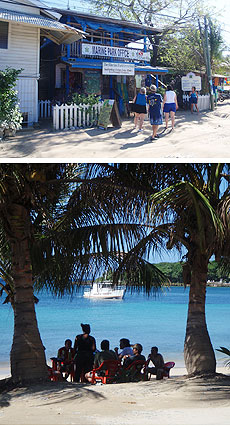 On Wednesday we did a day trip to the other side of the island by boat. I wasn’t feeling great as the relentless wind and perhaps some infection had conspired to make my head feel stopped up and I felt pretty miserable. We almost didn’t go, but I wasn't going to skip precious dives unless it was absolutely necessary. I felt better on the boat and we ended up having three terrific dives. Two of them were drift dives where the boat dropped us off and then picked us up a ways down-current. I saw sea turtles for the first time and a whole different underwater scenery than on the southside of Roatan. Instead of flat reefs and then walls, the northside has lots of fairly flat sandy areas and then spectacular sloping reefs.
On Wednesday we did a day trip to the other side of the island by boat. I wasn’t feeling great as the relentless wind and perhaps some infection had conspired to make my head feel stopped up and I felt pretty miserable. We almost didn’t go, but I wasn't going to skip precious dives unless it was absolutely necessary. I felt better on the boat and we ended up having three terrific dives. Two of them were drift dives where the boat dropped us off and then picked us up a ways down-current. I saw sea turtles for the first time and a whole different underwater scenery than on the southside of Roatan. Instead of flat reefs and then walls, the northside has lots of fairly flat sandy areas and then spectacular sloping reefs.
Captain Ruben docked the boat at Half Moon Bay and we had a picnic on the boat. Then there was an hour or so of free time to explore West End. This was quite an experience. The main drag was unpaved and essentially one pothole next to the other. There were colorful little shops and boutiques and even PADI “5-star†diveshops, all in modest clapboard huts. It was probably more primitive than what I remember from vacations in Spain and France in the late 1950s. We bought a couple of little knicknacks though Carol was taken aback when Christmas ornaments she liked carried the dreaded “Made in China†sticker. She told the crest-fallen salesgirl we wanted things made on the island and hadn’t come all this way to buy stuff made in China.
The boat ride back was rough. The beer coolers were open now and there was Rum and Tequila, and so the drinking contingent of our boat, which was most, had a grand time and seemed wholly unaffected by the boat’s tossing and pitching. And a pit stop halfway home served to relieve accumulated pressures. We were unaffected, too, but there were times when I wasn’t sure how much more the boat could take. I was happy to find that apparently I don’t succumb to seasick easily, though I won’t be taking that for granted.
On the last day of diving we got to see the wreck of Mr. Bud, a fishing and cargo ship resting on a sand bank at the edge of a wall at 50 to 65 feet of water. Visibility was excellent and I actually got to take in the whole wreck from a distance as opposed to seeing just seeing the bits and pieces within viewing range. The wreck also had been underwater for just a few years, so things were not quite as rosted and encrusted as on the Prince Albert. I had my divelight with me and actually penetrated the hull of the wreck. It had all been prepped for divers, but it was a first for me, and exciting.
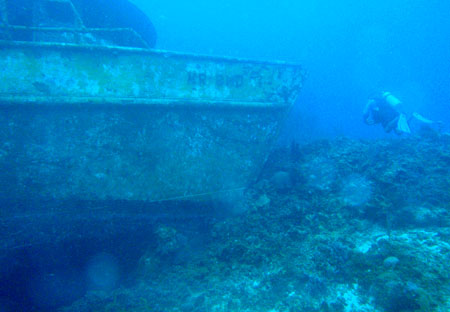
Every trip I’ve made in my life has been different. I’ll remember this one as my second ocean dive trip with many wonderful dives, but also for the observations I made and things I learned about diving and dive trips.
Allergies and colds
I’d been taught that diving while suffering from allergies or having a cold is inadvisable, or even dangerous. This has to do with the clogging up of sinus cavities that may make it difficult or impossible to equalize pressure in your ears or result in blockages elsewhere. This time I found myself with fairly severe allergies, probably due to the wind that stirred up all sorts of allergens I was not used to. This began on Tuesday and I really did not want to miss diving the rest of the week. So I decided to give it a try.
Amazingly, I encountered very little problem. Equalizing was a bit more difficult (and a bit noisier), but it did not pose any real difficulties. A couple of times I encountered sinus pressure and pain in my forehead right above my eyes. Whenever that happened I simply stopped descent and ascended a couple of feet. This almost always made the pain/pressure disappear and I resumed descent. I was able to do another seven or eight dives, including one below 100 feet without any pain or other issues. If anything, diving felt like a relief from feeling somewhat miserable on the surface.
This does not mean that I recommend diving while suffering from allergies or having a cold. It just means that in my case, it did not mean the end of diving for the week. If anyone finds him/herself in the same situation, I’d recommend finding out what can be done rather than just giving up.
Insects
Insect bites can be a major pain on dive vacations. Roatan’s infamous “no-see-ums†were out in force and three days into our stay we were covered in nasty red bites. This seemed to happen no matter what we did, and no matter how we tried to protect ourselves. While we hacked and coughed from the fumes every time we sprayed arms, calves, neck and every other exposed part of the body, the no-see-ums appeared unaffected and everyone was covered by bites. Nasty red dots that then spread and began itching so much that scratching till things were raw seemed a preferable alternative. No fun.
Interestingly, the divemasters and dockside staff seemed immune and had no bites. I asked our divemaster, Jessie, and he grinningly said his skin was too dark and tough for the bugs. I shopped for a second opinion and found that the locals attribute their relative immunity to their diet that includes fragrant oils and a lot of vinegar. The vinegar supposedly changes the acidity of the body and skin, and keeps the pesky little buggers away.
At times I felt irrational frustration and anger against the bugs. Our beach house was beautifully located and a gorgeous beach beckoned, as did walks along the beach and through the luscious groves. But there was a price to pay in terms of insect bites, and that price simply was too steep. So we stayed mostly indoors.
Clothing
Somehow it seems impossible to ever pack the right clothes. When I lived in upstate New York I used to assume it was cold everywhere else, too, and overpack. Now that I live in sunny California I generally don’t pack things that are warm enough in colder parts of the country. Fortunately, the wardrobe requirements for the kinds of traveling I usually do are modest, and if push comes to shove, there’s usually a Target or Wal-Mart closeby to buy things.
For this trip the weather report had predicted temperatures in the low 80s during the day and low 70s at night, and so I only brought one pair of blue jeans and one long-sleeved shirt. That was not enough. There wasn’t much rain during the week, but it was windy, which means wind chill factor. Sitting on a dive boat in a wetsuit with the wind blowing is a miserable experience. As a result, the local dive shop quickly sold out of Chammyz, the cozy, warm dive and actionwear. They had 20 of them or so the beginning of the week, and they were all gone by Friday.
Dive skins
Almost every serious diver I ever met has been singing the praises of dive skins. Dive skins are ultra-light full-body garments that look like wetsuits but are much lighter. Depending on whom you talk to, they either look like those snazzy high-tech suits worn by Olympic swimmers, or like ballet tights (I think it’s the former).
Dive skins are usually worn in really warm water (85 degrees on up) or under a wetsuit. You don’t really need a full-body suit in such 85+ degree water, but some divers (including myself) like to have their skin covered so that things don’t sting or bite as easily.
On this trip, I bought a dive skin because I simply felt too cold with just the 3/2 mm wetsuit. So now I know what a dive skin does, and does not, do. First, a wetsuit goes on a hundred times easier if you wear a dive skin. No more struggling; the wetsuit simply glides on. However, do NOT expect to be warmer underwater. I wore the dive skin under my 3/2 mm wetsuit on several dives in 78-80 degree water (which, amazingly, feels pretty cold after a while) and actually felt colder with the dive skin than without. I think that’s because of the way wetsuits work. A wetsuit is designed to let in a thin layer of water that is then warmed up by the body. The wetsuit does not easily let the warmed-up water layer escape, and so it acts as insulation and keeps you warm. If you wear a dive skin under the wetsuit, the dive skin sort of disrupts that insulating layer of water and you feel colder. I know, it doesn’t sound logical that wearing more should make you feel colder, but in this case it does. I am not sorry I bought the dive skin though. It looks and feels great, and it serves a number of purposes. It also stows away into a tiny packager that fits almost anywhere. How much did it cost? I paid US$95 for an Akona XL dive skin at the Dockside dive shop at CoCo View.
Taking pictures underwater
I’ve been taking pictures for what seems like forever, and underwater pictures for a good while. Yet, every time I go diving with a camera I am reminded that taking pictures underwater is absolutely and totally different from taking pictures on land.
On land, cameras have it easy. All they have to do is measure the light, determine aperture and shutter speed, focus, and then take the picture. If there isn’t enough light they use the flash to help out. So what’s different in the water?
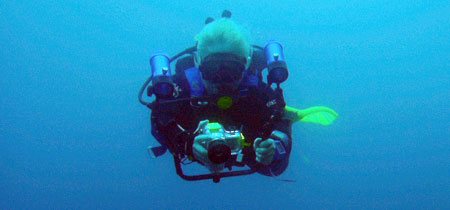
Well, there is much less light for starters. And whatever light there is acts differently from the surface. Certain colors disappear at fairly shallow depths. Red is gone at 15 feet or so. Orange and yellow soon follow. Which means that everything looks greenish-blue, which looks pleasant enough when you swim through it, but much less so in a picture. Add visibility that is MUCH less than on the surface and hunting for light becomes a huge challenge even for the best cameras. To provide perspective, on land you can often literally see for many miles. Underwater, divers are thrilled when they have 100 feet or so. Even “gin-clear†water rarely has more visibility than 150 feet. And I’ve been on many a dive where visibility was just four or five feet, which is much less than even the densest fog.
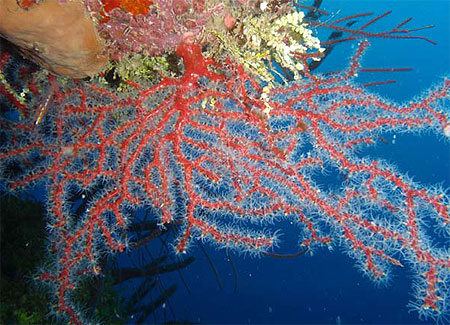
As if inadequate light and limited visibility weren’t enough of a problem, there’s so much stuff moving in the water that most auto-focus systems are simply overwhelmed. When just about everything is moving, what should the camera focus on? Fixed focus or automatic spot focus are almost a must for decent pictures, and even then they are far from guaranteed as focusing systems need enough light to do their job.
Add to that the fact that not only is the whole scenery moving constantly, but so are you. Even the most advanced divers seldom remain completely motionless; there are always little corrections, or the surge moves you back and forth. This makes an active, optical anti-shake system pretty much mandatory. Digital anti-shake really doesn’t work as it’s based on increasing sensitivity and shutter speed, an approach that doesn’t work well underwater. Why not hold on to something or sit down? Easier said than done. Many resorts and marine parks prohibit the wearing of gloves to discourage touching coral and plant life, plus the water will rock and sway you anyway even if you were to hold on to something. Sitting or laying down is also not a good idea as it either disturbs plants and critters or stirs up silt and sand, or both.
With so little light most of the time, you need a good flash, right? Yes and no. A flash can do wonders for macro photography, but it is worse than useless in just about any other situation. That’s because a built-in flash will illuminate every tiny piece of flotsam and jetsam producing what underwater photographers call “scatter.†In anything but the clearest water, flash-generated scatter makes most pictures unusable. Now, as far as I am concerned cameras should know that but most don’t. If the camera is set on auto-flash, it’ll use the flash with almost every picture underwater, rendering them useless. So you find yourself in the unenviable position of not having enough light, but also not being able to use the flash.
Many cameras for which underwater housings are available have underwater settings. Problem is, it’s not always clear what they do. The otherwise excellent Olympus Stylus 1030SW I used has “underwater wide 1†and “underwater wide 2†settings, but virtually no explanation as to the settings used. Select “underwater macro†and the camera goes into full 3.6x tele mode for no apparent reason, so by using the special macro setting I actually had to move farther away from a subject than in regular automatic mode. What this means is that you really need to know your camera and all of its controls. And those controls can be different when you use the underwater housing.
And then there are those little obvious things that can trip us. Like forgetting the power supply, memory card adapter, or memory cards themselves. Some items you can buy at your destination, but it’s, for example, hard to find an xD-Picture card adapter for micro-SD cards or some such. In the olden days all you needed was film. Today it’s a whole slew of things that can put your camera out of commission.
Mask defog
There are few things more infuriating that a fogged-up mask when you’re underwater. Everyone has their own special way of making sure the mask doesn’t fog up, ranging from expensive, exotic defoggers to home-grown mixtures to good old-fashioned spit. I remember at least one dive where absolutely nothing worked and my mask was fogged up the whole dive. This time, the opposite was true. My mask didn’t fog once, and it didn’t leak at all either. I’ve come to really love and appreciate my Scubapro Frameless mask and attribute the absence of leaking to its superior design and materials, but why this trip I didn't have any fogging problems at all I do not know (Carol thinks it's because I used the defog stuff she likes). Even if I had, by the way, by now I figured out how to let a little bit of water into the mask and then swirl it around to clear the mask from fogging.
So there, my second trip to Roatan, another great week of diving.
The flight back was uneventful. I’d dreaded another long, hot, crowded flight from Houston to Sacramento in a leg- and elbowroom-challenged Continental jet, but things went fairly smoothly. I ended up sitting next to a guy who turned out to be a scuba instructor and tech diver from Reno. He and his girlfriend had been diving in Belize. He’d read many of the same scuba enthusiast books as I had, so there was lots to talk about, though he was light-years more experienced than I. I must have come across as reasonably knowledgeable as early on in the conversation he inquired whether I was perchance Bruce Wienke, the decompression guru. Anyway, I was surprised how quickly a 4-1/2 hour flight goes by with good conversation.
Posted by conradb212 at December 21, 2008 8:33 PM








